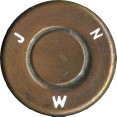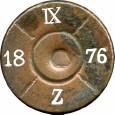After losing the Austro-Prussian war of 1866 at the battle of Königgrätz, the Austrian army began the search to replace their ageing Lorenz muzzle-loading rifles. The first modifications were done by Vienna gunsmith Karl Wänzel who converted the muzzle-loading percussion actions to rimfire breech-loaders. Changes in the European political landscape led to armies modernizing and re-equipping their militaries, so the percussion cap-to-breech loader was always just a temporary solution. In early 1867, the Austrian Military Commission adopted a design by innovative designer and businessman Josef Werndl (1831-1889). Together with his factory foreman and engineer Karel Holub (1830-1903) they designed the Werndl-Holub Rifle It was a single-shot breechloading rifle that the Austro-Hungarian army adopted in 1867 and it replaced the Wänzel conversion of the muzzle-loading Lorenz rifle. Their design was revolutionary in two aspects, namely the locking mechanism (tabernacle lock, or Wellblockverschluss mit Lademulde) and secondly Werndl’s business acumen in modernising manufacturing methods that allowed the Oesterreichische Waffenfabriks-Gesellschaft (OeWG) in Steyr to produce large quantities of rifles of high quality and acceptable cost which led to the OeWG becoming one of the largest European producers of small arms in later years.

It was interesting to note that the first rifles were also designed around the Remington rimfire cartridge and tests were conducted on both rim fire and centerfire cartridges by the military and the Werndl design was chosen over the Remington Rolling Block design, even after troop trials with the Remingtons were already being conducted in Germany. It was during 1867 that the cartridge design was changed from rimfire to centerfire and the case was necked down to 11.15mm with a case length of 41mm although it was still debatable whether to use rimfire of centerfire as the design on primer systems were still in its infancy.

 IGNATZ NOVOTNY, WIEN loaded with Wilburger primer. See also Hoyem Vol. 2 p. 174 (CFR 154)
IGNATZ NOVOTNY, WIEN loaded with Wilburger primer. See also Hoyem Vol. 2 p. 174 (CFR 154)
The original priming system used was invented by ordnance Officer Martin Wilburger. It was a complicated design as the case was first formed similar to the UMC Folded Head design and then the primer was inserted via the case mouth and crimped in place. It was therefore not possible for troops to reload the cases in the field without proper machinery as the whole process was done at factory level. The Wilburger priming system was therefore only a stopgap measure until the correct design could be found. At the time various trials were conducted to find a solution, which came through Austrian designer Georg Roth with his Roth Patent Primer. It incorporated a design containing all the elements for ignition, including anvil in the base cup and was loaded from the rear. It is a design, whether boxer or berdan, that is still in use up to this day. Roth beat his competitor, Hotchkiss and his design was adopted on the 28th of December 1869, with official production starting in 1870.
 Fired Case with later Roth primer. The Z was for Zboril Consortium, Vienna-Simmering
Fired Case with later Roth primer. The Z was for Zboril Consortium, Vienna-Simmering
See also:
https://ww1.habsburger.net/de/kapitel/vom-koeniggraetzer-lorenz-gewehr-zur-ordonnanz-waffe-m1895
http://www.austro-hungarian-army.co.uk/biog/werndl.htm
